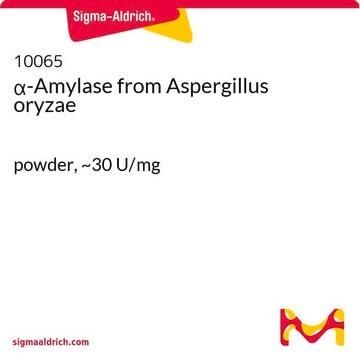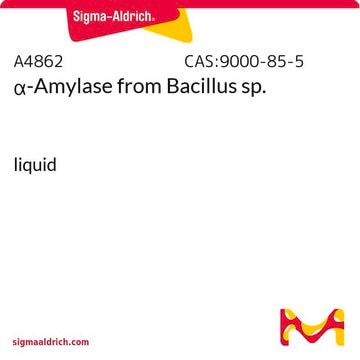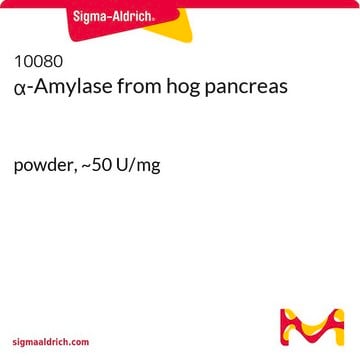This product is soluble in water. No additional calcium is required. For specific applications it may also be prepared in typical sodium or potassium phosphate buffer solutions.
Wichtige Dokumente
10069
α-Amylase aus Bacillus sp.
powder, yellow-brown, ~380 U/mg
Größe auswählen
70,90 €
Versandbereit am07. April 2025Details
Größe auswählen
About This Item
70,90 €
Versandbereit am07. April 2025Details
Empfohlene Produkte
Biologische Quelle
Bacillus sp.
Form
powder
Spezifische Aktivität
~380 U/mg
Grünere Alternativprodukt-Eigenschaften
Waste Prevention
Design for Energy Efficiency
Learn more about the Principles of Green Chemistry.
sustainability
Greener Alternative Product
Farbe
yellow-brown
Grünere Alternativprodukt-Kategorie
, Enabling
Lagertemp.
2-8°C
Suchen Sie nach ähnlichen Produkten? Aufrufen Leitfaden zum Produktvergleich
Verwandte Kategorien
Allgemeine Beschreibung
Anwendung
- as a dispersal enzyme to test degradation of S. aureus biofilms[2],
- in the enzymatic hydrolysis of tapioca starch[3]
- in the enzymolysis of plant-based native and the amorphous granular starches[4]
Biochem./physiol. Wirkung
Einheitendefinition
Signalwort
Danger
H-Sätze
P-Sätze
Gefahreneinstufungen
Resp. Sens. 1
Lagerklassenschlüssel
11 - Combustible Solids
WGK
WGK 1
Flammpunkt (°F)
Not applicable
Flammpunkt (°C)
Not applicable
Persönliche Schutzausrüstung
dust mask type N95 (US), Eyeshields, Faceshields, Gloves
Hier finden Sie alle aktuellen Versionen:
Besitzen Sie dieses Produkt bereits?
In der Dokumentenbibliothek finden Sie die Dokumentation zu den Produkten, die Sie kürzlich erworben haben.
Kunden haben sich ebenfalls angesehen
-
In which solution I should to dissolve the alfa amylase? should had ca+2? (for starch degradation)
1 Antwort-
Hilfreich?
-
Aktive Filter
Unser Team von Wissenschaftlern verfügt über Erfahrung in allen Forschungsbereichen einschließlich Life Science, Materialwissenschaften, chemischer Synthese, Chromatographie, Analytik und vielen mehr..
Setzen Sie sich mit dem technischen Dienst in Verbindung.












